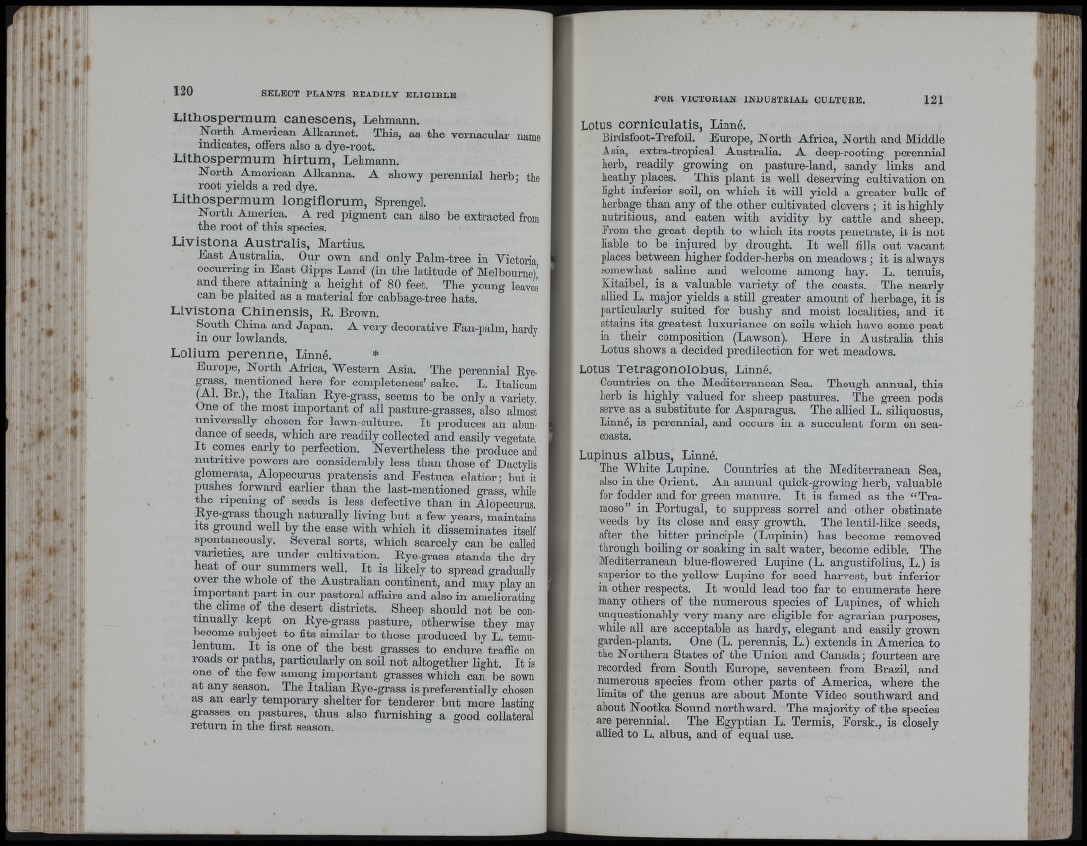
11
Lithospermum canescens, Lehmann.
North American Alkannet. This, as the vernacular name
indicates, offers also a dye-root.
Lithospermum hirtum, Lehmann.
North American Alkanna. A showy perennial herb- the
root yields a red dye. ’
Lithospermum longiflorum, Sprengel.
North America. A red pigment can also be extracted from
the root of this species.
Livistona Australis, Martins.
East Australia. Our own and only Palm-tree in Victoria
occurring in East Gipps Land (in the latitude of Melbourne?
and there attaining a height of 80 feet. The young leaves
can be plaited as a material for cabbage-tree hats.
Livistona Chinensis, R Brown.
South China and J apan. A very decorative Fan-palm, hardy
in our lowlands.
Lolium perenne, Linné. *
Europe, North Africa, Western Asia. The perennial Ryegrass,
mentioned here for completeness’ sake. L. Italicum
(Al. Br.), the Italian Bye-grass, seems to be only a variety,
One of the most important of all pasture-grasses, also almost
universally chosen for lawn-culture. I t produces an abundance
of seeds, which are readily collected and easily vegetate.
I t comes early to perfection. Nevertheless the produce and
nutritive powers are considerably less than those of Dactylis
glomerata, Alopecurus pratensis and Eestuca elatior; but it
pushes forward earlier than the last-mentioned grass, while
the ripening of seeds is less defective than in Alopecurus.
Bye-grass though naturally living but a few years, maintains
its ground well by the ease with which it disseminates itself
spontaneously. Several sorts, which scarcely can be called
varieties, are under cultivation. Bye-gi'ass stands the dry
heat of our summers well. I t is likely to spread gradually
over the whole of the Australian continent, and may play an
important part in our pastoral affairs and also in ameliorating
the clime of the desert districts. Sheep should not be continually
kept on Bye-grass pasture, otherwise they may
become subject to fits similar to those produced by L. temu-
lentum. I t is one of the best grasses to endure traffic on
roads or paths, particularly on soil not altogether light. It is
one of the few among important grasses which can be sown
at any season. The Italian Bye-grass is preferentially chosen
as an early temporary shelter for tenderer bnt more lasting
grasses on pastures, thus also furnishing a good collateral
return in the first season.
Lotus corniculatis, Linné.
Birdsfoot-Trefoil. Europe, North Africa, North and Middle
Asia, extra-tropical Ausfr’alia. A deep-rooting perennial
herb, readily growing on pasture-land, sandy links and
heathy places. This plant is well deserving cultivation on
light inferior soil, on which it will yield a greater bulk of
herbage than any of the other cultivated clovers ; it is highly
nutritious, and eaten with avidity by cattle and sheep.
From the great depth to which its roots penetrate, it is not
liable to be injured by drought. I t well fills out vacant
places between higher fodder-herbs on meadows ; it is always
somewhat saline and welcome among hay. L. tenuis,
Kitaibel, is a valuable variety of tlie coasts. Tbe nearly
allied L. major yields a still greater amount of herbage, it is
particularly suited for bushy and moist localities, and it
attains its greatest luxuriance on soils which have some peat
in their composition (Lawson). Here in Australia this
Lotus shows a decided predilection for wet meadows.
Lotus Tetragonolobus, Linné.
Countries on the Mediterranean Sea. Though annual, this
herb is highly valued for sheep pastures. The green pods
serve as a substitute for Asparagus. The allied L. siliquosus,
Linné, is perennial, and occurs in a succulent form on sea-
coasts.
Lupinus albus, Linné.
The White Lupine. Countries at the Mediterranean Sea,
also in the Orient. An annual quick-growing herb, valuable
for fodder and for green manure. I t is famed as tbe “ Tramóse”
in Portugal, to suppress sorrel and other obstinate
weeds by its close and easy growth. Tbe lentil-like seeds,
after the bitter principle (Lupinin) has become removed
through boiling or soaking in salt water, become edible. The
Mediterranean blue-flowered Lupine (L. angustifolius, L.) is
superior to tbe yellow Lupine for seed harvest, but inferior
in other respects. I t would lead too far to enumerate here
many others of the numerous species of Lupines, of which
unquestionably very many are eligible for agrarian purposes,
while all are acceptable as hardy, elegant and easily grown
garden-plants. One (L. perennis, L.) extends in America to
the Northern States of the Union and Canada; fourteen are
recorded from South Europe, seventeen from Brazil, and
numerous species from other parts of America, where the
limits of the genus are about Monte Video southward and
about Nootka Sound northward. The majority of the species
are perennial. The Egyptian L. Termis, Forsk., is closely
allied to L. albus, and of equal use.
f, ■
Î
. (
■
'Ai’l- i'. 1 ■ ' 'Mr'",.'.: .
!■ ■, ■ ■ ■ *
■Í 4
»
Ml :4 1. ’■ ■' I
U í ' . í
S :■ '■ ii